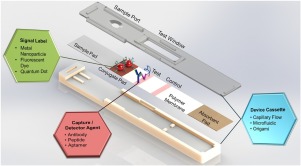当前位置:
X-MOL 学术
›
Nano Today
›
论文详情
Our official English website, www.x-mol.net, welcomes your
feedback! (Note: you will need to create a separate account there.)
Strategies for developing sensitive and specific nanoparticle-based lateral flow assays as point-of-care diagnostic device
Nano Today ( IF 13.2 ) Pub Date : 2020-02-01 , DOI: 10.1016/j.nantod.2019.100831 Jun Hui Soh , Hsi-Min Chan , Jackie Y. Ying
Nano Today ( IF 13.2 ) Pub Date : 2020-02-01 , DOI: 10.1016/j.nantod.2019.100831 Jun Hui Soh , Hsi-Min Chan , Jackie Y. Ying

|
Abstract From a home-based pregnancy self-testing kit, lateral flow assays (LFAs) have proliferated and gained widespread utilization as point-of-care (POC) test kits. Their prevalence is due to their portability, rapid time-to-result, simplicity, stability, and cost-effectiveness. LFAs are well-suited for early detection of infectious diseases, which threatens public health and the economy, enabling timely medical intervention, and management of disease and treatment. This is vital for rural and resource-limited settings where well-equipped laboratories with well-trained personnel are scarce. Nevertheless, LFAs have certain limitations, such as moderate sensitivity and target throughput, as compared to lab-based technologies. Also, the development of LFA, although well-defined, is not straightforward. In this review article, we will elucidate the iterative process of LFA development, and discuss strategies for generating sensitive and specific capture/detector agents, multiplexed detection and signal amplification. An important starting point in LFA development is the clear definition/identification of design inputs and predicate. Newly engineered capture/detector agents, such as nanobodies and aptamers, should possess high binding affinity and functionality in body fluid samples for practical field application. Also, chemical methods, combined with engineering, have enabled multiplexing and signal amplification capabilities for higher target throughput and detection sensitivity. Furthermore, LFAs can be augmented or adapted to other platforms, such as smartphone, spectroscopy and electrochemistry, for quantitative measurements that can engender wider applications and adoption. Through these advances, LFA will transform into a genuinely versatile platform, capable of delivering accurate results that are similar to lab-based technologies, while retaining its advantage as a simple, portable, inexpensive and rapid test.
中文翻译:

开发敏感和特异的基于纳米颗粒的横向流动检测作为床旁诊断设备的策略
摘要 从家用妊娠自我检测试剂盒中,侧向流检测 (LFA) 已激增并被广泛用作即时 (POC) 检测试剂盒。它们的流行是由于它们的便携性、快速的结果时间、简单性、稳定性和成本效益。LFA 非常适合早期发现威胁公共健康和经济的传染病,从而能够及时进行医疗干预以及疾病管理和治疗。这对于农村和资源有限的环境至关重要,在这些环境中,装备精良的实验室和训练有素的人员稀缺。然而,与基于实验室的技术相比,LFA 有一定的局限性,例如中等灵敏度和目标通量。此外,LFA 的开发虽然定义明确,但并不简单。在这篇评论文章中,我们将阐明 LFA 开发的迭代过程,并讨论生成敏感和特异的捕获/检测剂、多重检测和信号放大的策略。LFA 开发的一个重要起点是设计输入和谓词的明确定义/识别。新设计的捕获/检测剂,如纳米抗体和适体,应在体液样品中具有高结合亲和力和功能,以用于实际现场应用。此外,化学方法与工程相结合,实现了多路复用和信号放大功能,可实现更高的目标通量和检测灵敏度。此外,LFA 可以增强或适应其他平台,例如智能手机、光谱学和电化学,用于可以产生更广泛应用和采用的定量测量。通过这些进步,LFA 将转变为一个真正的多功能平台,能够提供类似于实验室技术的准确结果,同时保持其简单、便携、廉价和快速测试的优势。
更新日期:2020-02-01
中文翻译:

开发敏感和特异的基于纳米颗粒的横向流动检测作为床旁诊断设备的策略
摘要 从家用妊娠自我检测试剂盒中,侧向流检测 (LFA) 已激增并被广泛用作即时 (POC) 检测试剂盒。它们的流行是由于它们的便携性、快速的结果时间、简单性、稳定性和成本效益。LFA 非常适合早期发现威胁公共健康和经济的传染病,从而能够及时进行医疗干预以及疾病管理和治疗。这对于农村和资源有限的环境至关重要,在这些环境中,装备精良的实验室和训练有素的人员稀缺。然而,与基于实验室的技术相比,LFA 有一定的局限性,例如中等灵敏度和目标通量。此外,LFA 的开发虽然定义明确,但并不简单。在这篇评论文章中,我们将阐明 LFA 开发的迭代过程,并讨论生成敏感和特异的捕获/检测剂、多重检测和信号放大的策略。LFA 开发的一个重要起点是设计输入和谓词的明确定义/识别。新设计的捕获/检测剂,如纳米抗体和适体,应在体液样品中具有高结合亲和力和功能,以用于实际现场应用。此外,化学方法与工程相结合,实现了多路复用和信号放大功能,可实现更高的目标通量和检测灵敏度。此外,LFA 可以增强或适应其他平台,例如智能手机、光谱学和电化学,用于可以产生更广泛应用和采用的定量测量。通过这些进步,LFA 将转变为一个真正的多功能平台,能够提供类似于实验室技术的准确结果,同时保持其简单、便携、廉价和快速测试的优势。











































 京公网安备 11010802027423号
京公网安备 11010802027423号